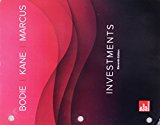
Concept explainers
a.
To analyze: The choice of inclusion of the portfolio in the holdings if the market-index portfolio is held.
Introduction:
Market-Index portfolio: When anyone has to calculate the cumulative value of various stocks, the choice of using market-index portfolio is ideal. Here the word index refers to the movement of the securities along with the one in the market for a long term.
b.
To analyze: The choice of portfolio if the investment is possible only in T-Bills.
Introduction:
Market-Index portfolio: When anyone has to calculate the cumulative value of various stocks, the choice of using market-index portfolio is ideal. Here the word index refers to the movement of the securities along with the one in the market for a long term.
Want to see the full answer?
Check out a sample textbook solution
Chapter 24 Solutions
GEN COMBO LOOSELEAF INVESTMENTS; CONNECT ACCESS CARD
- Which of the following best defines the term "capital structure"?A) The way a company raises its capital through debt and equityB) The investment decisions made by a companyC) The amount of profit a company generatesD) The distribution of earnings to shareholdershelparrow_forwardWhich of the following best defines the term "capital structure"?A) The way a company raises its capital through debt and equityB) The investment decisions made by a companyC) The amount of profit a company generatesD) The distribution of earnings to shareholdersarrow_forwardThe time value of money concept is based on the idea that: A) Money loses value over timeB) Money has the same value over timeC) The value of money increases over time due to inflationD) A dollar today is worth more than a dollar in the futurehelparrow_forward
- The time value of money concept is based on the idea that: A) Money loses value over timeB) Money has the same value over timeC) The value of money increases over time due to inflationD) A dollar today is worth more than a dollar in the future explain.arrow_forwardThe time value of money concept is based on the idea that: A) Money loses value over timeB) Money has the same value over timeC) The value of money increases over time due to inflationD) A dollar today is worth more than a dollar in the futurearrow_forwardWhich of the following is the most appropriate metric for determining a company's profitability?A) Return on Assets (ROA)B) Debt-to-Equity RatioC) Price-to-Earnings (P/E) RatioD) Current Ratio need helparrow_forward
- Which of the following is the most appropriate metric for determining a company's profitability?A) Return on Assets (ROA)B) Debt-to-Equity RatioC) Price-to-Earnings (P/E) RatioD) Current Ratio explain.arrow_forwardWhich of the following is the most appropriate metric for determining a company's profitability?A) Return on Assets (ROA)B) Debt-to-Equity RatioC) Price-to-Earnings (P/E) RatioD) Current Ratioarrow_forwardWhat does the term "liquidity" refer to in financial management?A) The profitability of a companyB) The ease with which an asset can be converted into cashC) The long-term sustainability of a companyD) The company's capital structure helparrow_forward
- What does the term "liquidity" refer to in financial management?A) The profitability of a companyB) The ease with which an asset can be converted into cashC) The long-term sustainability of a companyD) The company's capital structurearrow_forwardWhich of the following is a method for valuing a stock using expected future dividends?A) Net Present Value (NPV)B) Dividend Discount Model (DDM)C) Price-to-Earnings (P/E) RatioD) Internal Rate of Return (IRR) explain.arrow_forwardWhich of the following is a method for valuing a stock using expected future dividends?A) Net Present Value (NPV)B) Dividend Discount Model (DDM)C) Price-to-Earnings (P/E) RatioD) Internal Rate of Return (IRR)arrow_forward
 Essentials Of InvestmentsFinanceISBN:9781260013924Author:Bodie, Zvi, Kane, Alex, MARCUS, Alan J.Publisher:Mcgraw-hill Education,
Essentials Of InvestmentsFinanceISBN:9781260013924Author:Bodie, Zvi, Kane, Alex, MARCUS, Alan J.Publisher:Mcgraw-hill Education,

 Foundations Of FinanceFinanceISBN:9780134897264Author:KEOWN, Arthur J., Martin, John D., PETTY, J. WilliamPublisher:Pearson,
Foundations Of FinanceFinanceISBN:9780134897264Author:KEOWN, Arthur J., Martin, John D., PETTY, J. WilliamPublisher:Pearson, Fundamentals of Financial Management (MindTap Cou...FinanceISBN:9781337395250Author:Eugene F. Brigham, Joel F. HoustonPublisher:Cengage Learning
Fundamentals of Financial Management (MindTap Cou...FinanceISBN:9781337395250Author:Eugene F. Brigham, Joel F. HoustonPublisher:Cengage Learning Corporate Finance (The Mcgraw-hill/Irwin Series i...FinanceISBN:9780077861759Author:Stephen A. Ross Franco Modigliani Professor of Financial Economics Professor, Randolph W Westerfield Robert R. Dockson Deans Chair in Bus. Admin., Jeffrey Jaffe, Bradford D Jordan ProfessorPublisher:McGraw-Hill Education
Corporate Finance (The Mcgraw-hill/Irwin Series i...FinanceISBN:9780077861759Author:Stephen A. Ross Franco Modigliani Professor of Financial Economics Professor, Randolph W Westerfield Robert R. Dockson Deans Chair in Bus. Admin., Jeffrey Jaffe, Bradford D Jordan ProfessorPublisher:McGraw-Hill Education





